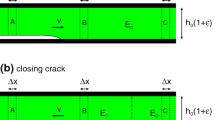Abstract
A new derivation and interpretation of the energy balance formula for a continuum with propagating crack are given. Using the formula obtained in this way for the crack driving force, a Griffith's type criterion of crack growth in a thermo-mechanical quasistatic process of deformation and rupture in an arbitrary continuum is proposed.
The modified Griffith criterion is then applied to the study to the study of rupture in a linear viscoelastic medium. Behavior of cracks in an unbounded plane loaded uniformly at infinity, or loaded by a pair of concentrated forces at the crack center is considered in detail.
In the former case of an unstable crack, a delay of rupture in a certain range of loading is discovered. Thus, the kinetics of rupture rather than that of the crack in viscoelastic media for an ideal brittle model of rupture are established.
For the latter case of a stable crack, a jumplike manner of rupture progression is found. The influence of the history of loading and creation of initial crack on the process of rupture is discussed.
Résumé
On donne une nouvelle forme de dérivation et d'interprétation de la formule d'équilibre énergétique dans le cas d'un continuum comportant une fissure en propagation. En utilisant la formulation obtenue par cette voie pour décrire la force d'entrainement de la fissure, on propose un critère de croissance de fissure de type Griffith, applicable à un processus de déformation et de rupture de caractère thermomécanique quasi-statique, dans un continuum arbitraire.
Le critère de Griffith modifié est ensuite appliqué à l'étude de rupture dans un milieu viscoélastique linéaire. On considère dans le détail le comportement de fissures dans un plan non limité et chargé à l'infini de manière uniforme, ou sollicité par un couple de forces concentrées au centre de la fissure.
Dans le premier cas d'une fissure instable, on trouve l'existence d'un retard à la rupture, sur une certaine gamme de charges. On en établit que c'est la cinétique de rupture plutôt que celle de la fissure qui gouverne un modèle idéal de rupture fragile, dans un milieu viscoélastique.
Dans le deuxième cas d'une fissure stable, on trouve que la rupture progresse par ressauts. On discute l'influence de l'histoire de la mise en charge, et de la création d'une fissure initiale sur le processus de rupture.
Similar content being viewed by others
References
M.L. Williams, in Fracture of Solids, Interscience Publishers, N.Y. (1963) 157–188.
B.V. Kostrov, L.V. Nikitin and L.M. Flitman, Mechanika tverdogo tela 3 (1969) 112–125 (in Russian).
B.V. Kostrov and L.V. Nikitin, Archiwum Mechaniki Stosawanej, 6, 22 (1970) 749–776.
M.Ya. Leonov and V.V. Panasyk, Prikladnaya mechanika, 4 (1959) 112–130 (in Russian).
B.V. Kostrov, L.V. Nikitin and L.M. Flitman, Physics of Solid Earth 7 (1970) 20–35 (in Russian).
L.N. McCartney, International Journal of Fracture 13 (1977) 641–654.
R.M. Christensen, International Journal of Fracture 15 (1979) 3–21.
L.N. McCartney, International Journal of Fracture 16 (1980) RCR 229–232.
R.M. Christensen, International Journal of Fracture 16 (1980) RCR 233–237.
C.H. Popelar and C. Atkinson, Journal of Mechanics and Physics of Solids 2 (1980) 79–93.
R.M. Christensen, Theory of Viscoelasticity, Academic Press (1971) 338.
G.A.C. Graham, Quaterly of Applied Mathematics 26 (1968) 167–180.
A.E. Molchanov and L.V. Nikitin, Mechanika tverdogo tela 2 (1972) 18–25 (in Russian).
L.I. Slepian, Mechanika tverdogo tela 4 (1973) 139–148 (in Russian).
Author information
Authors and Affiliations
Rights and permissions
About this article
Cite this article
Nikitin, L.V. Application of the Griffith's approach to analysis of rupture in viscoelastic bodies. Int J Fract 24, 149–157 (1984). https://doi.org/10.1007/BF00028058
Received:
Revised:
Issue Date:
DOI: https://doi.org/10.1007/BF00028058



